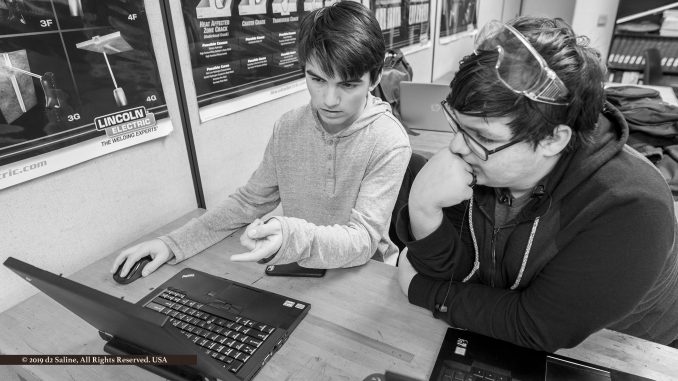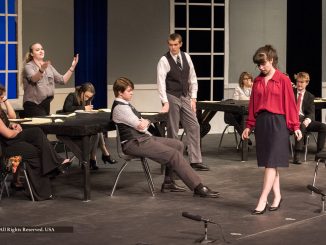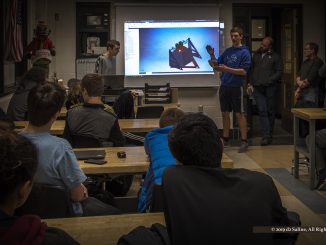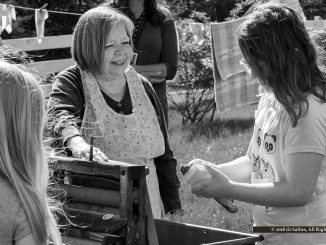
In many ways, the Saline Singularity Programming sub-team could be seen as microcosm for our high school FIRST Robotics Competition (FRC) team as a whole. A blend of Freshmen to Seniors, newcomers along side those who’d previously cut teeth in the middle school LEGO League, and students who’d walked into this thing without a lick of experience in any aspect of it. [1-3]
Now in week 6 of their robot build, Saline Journal sat down with those students who describe their contribution as that of making “sure that the robot does what you expect it to do when you move the control sticks.” For on-the-ground mobility, think something like the remote control vehicles they sell at Radio Shack. [4,5]
Beyond that, this robot needs to receive and predictably respond to directives aimed at its ancillary systems. Assemblies and attachments designed by the Saline Singularity CAD sub-team, prototyped, and built by the mechanical sub-team. Manipulated by devices such as onboard servos that depend upon circuit boards for command processing and safe batteries for power, brought into the mix by the electronics sub-team.
A great deal of this differs from game season to game season, based on what needs to be accomplished, in the face of further complicating obstacles. So, too with programming that supports all of the above. [6]
“We have access to a lot of program routine libraries provided by FRC,” said Branden Amstutz, a Saline High School Junior now in his third year with FIRST (two here, one in middle school). As Secondary Programming Lead, he was designated to brief Saline Journal on the functions of this sub-team. [7]
Libraries are provided by third parties and teams and they’re free for anyone to use. That saves a lot of time in getting basic functions to run — movement, lifting, manipulation. There’s no way you’re going to do a six week build if you have to do all that coding from scratch.
We write the brains of the robot. That makes these parts work together.
The biggest part of what we get to pick is our programming language. We write in Java. But you could write in JavaScript or C++ or Python. That’s probably what we’ll always use. We’ve had it since we started. [8-11]
Tonight the robot was elsewhere for further adjustments to its now attached intake mechanism — which has proven an increasing challenge a the clock ticks ever closer to the construction stop deadline of 11:59pm on February 21.
For the time being, that meant an opportunity for Mr Amstutz to work with Freshman Travis Crigger, another programmer on the team, in developing questions and a database for response capture on other FIRST Robotic Competition team capabilities. How did they approach the same engineering challenges going into Destination: Deep Space and where did that lead them with their ultimate design solutions?
Remember: FRC teams can advance either by scoring the greatest number of points per heats or by having themselves selected by a winning team for accompanying play at the next level. In addition to STEM and business acumen, there’s a social level of play at work here akin to what’s best exhibited on Survivor. [12]
“Team 6101 out of Washtenaw Technical Middle College picked us last year,” Branden Amstutz told us. “You want to know why. This is how you know that.” [13]
Taking a step or two back from the computer, the Programming sub-team has one final responsibility before competitions begin. It’s their job to devise means by which the actual field operators for the Saline Singularity robot will be selected. After being briefed on controller operation, these choices will be made solely on skills demonstrated. Those who served in this visible role last year are not guaranteed a place in the 2019 arenas.
Before leaving Mr Amstutz to continue guiding Mr Crigger through further intelligence gathering form development, we indulged one last curiosity. How much experience did each bring to day one of their time on respective Saline robotics teams?
“I had a lot of C++ and Python,” Travis Crigger assured Saline Journal. “But once you get one, you can figure your way around to getting the others,” he added matter-of-factly. Then we looked to Branden Amstutz for his answer.
He grinned, seemingly entertained by the question but nothing more. “I had no skills whatsoever.” And with that, he continued his collaboration on the next most important thing for which he was responsible on behalf of his team.
References
- Saline Singularity Team 5066 (home page).
- “First LEGO League” FIRST Inspire.
- “What’s Missing from This Image of the 2018 FIRST Robotics Championship in Detroit?” Dell Deaton (May 3, 2018) Saline Journal.
- “How Radio Controlled Toys Work” Jeff Tyson, How Stuff Works.
- “There Are Still Capable People Who Fix Their Own Electronics, Supported By A Local Resource To Keep Them Supplied” Dell Deaton (September 28, 2018) Saline Journal.
- “2019 FIRST Robotics Competition: Destination: Deep Space Game Animation” FIRSTRoboticsCompetition (January 5, 2019) YouTube.
- FIRST Inspires (home page).
- “What is Java technology and why do I need it?” Java.
- “What is JavaScript?” W3Schools.
- “C++ For Beginners – Learn about C++” David Bolton (March 30, 2017) ToughtCo.
- “What is Python? Executive Summary” Python.
- “Survivor” CBS.
- “2019 Season: Team 6101 – Strange Quarks” The Blue Alliance.



